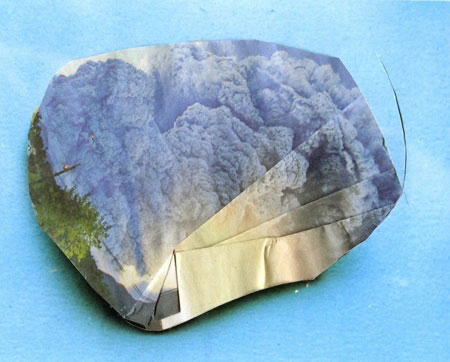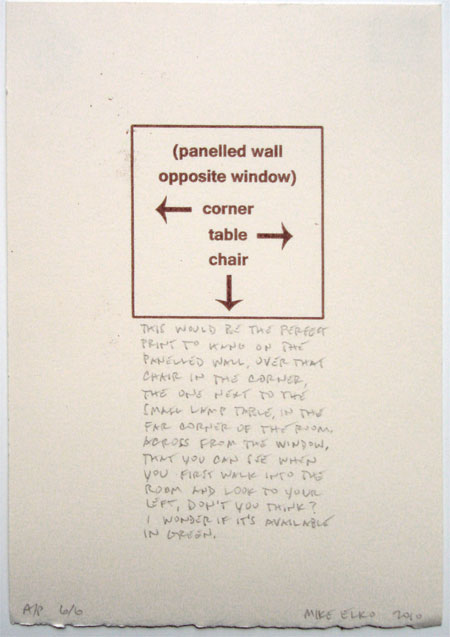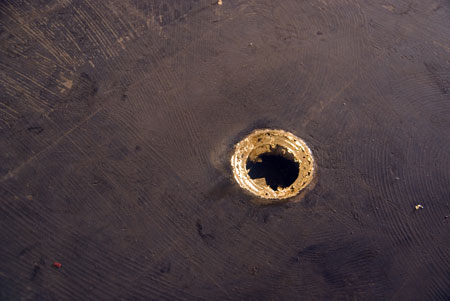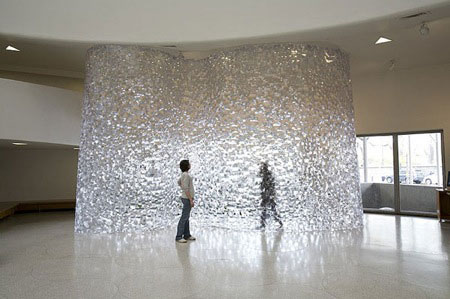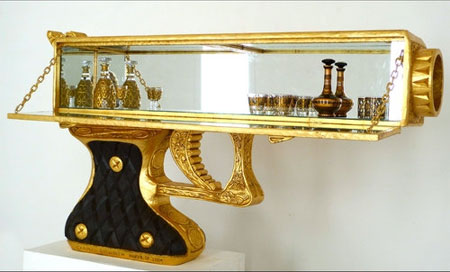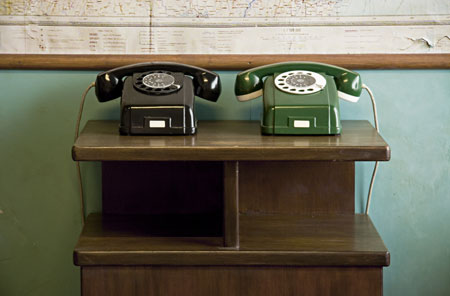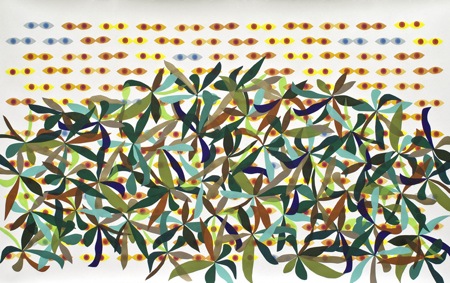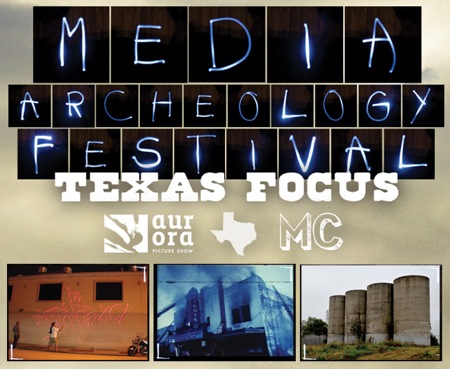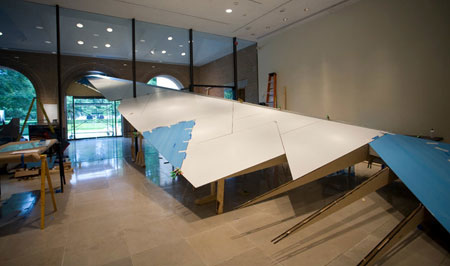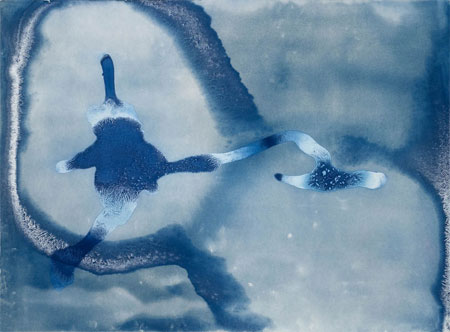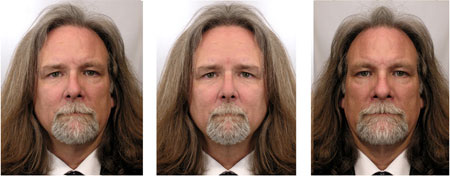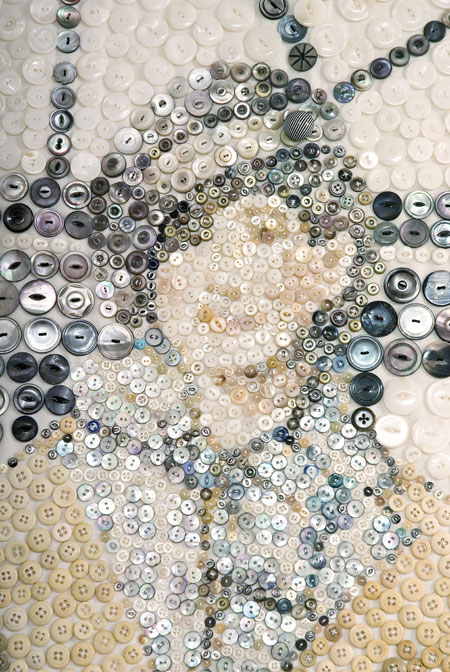Our best guesses for Fall 2010…
Albany
The Old Jail Art Center
Harry Geffert
September 25, 2010 – January 23, 2011
Harry Geffert is arguably the granddaddy of all those little bronze twig and tumbleweed castings you see in Texas galleries. It was Geffert, at his now-defunct Green Mountain Foundry, who refined the so-called “direct burn-out" process, which allows for very thin, delicate bronze casting from a flammable original (typically a twig, leaf, or other item from nature). In his latest work, he’s taken hundreds of these tiny castings and combined them into elaborate landscapes. It’s obsessive and a little nutty on the one hand, and as pleasingly desolate as a snowy winter scene on the other. [Note: Geffert is actually in a two-person show with sculptor James Sullivan, and Terri Thornton has her own solo show on view at the same time. All three artists merit mention—and particular kudos are in order to the Old Jail for putting together such a strong fall lineup.] – Rainey Knudson
Austin
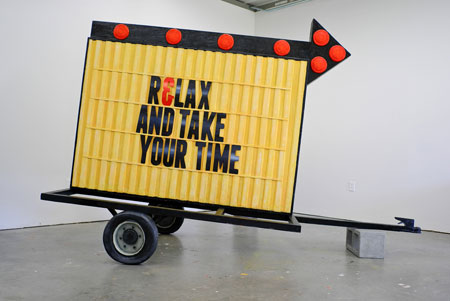
Untitled Project: SIGN, Relax and Take Your Time, 2010, oil on carved wood. Includes: carved marquee sign on trailer, cinderbloc
Lora Reynolds Gallery
Conrad Bakker: RELAX AND TAKE YOUR FUCKING TIME
September 16 – November 6
Conrad Bakker’s Untitled Projects (1997– ) is a series of sculptural works that are hand-carved and painted, rough-hewn replicas of consumer goods. Using eBay, garage sales, or classified ads, Bakker offers these handmade works at prices that approximate the value of their commercial counterparts. For example, earlier this year, one could have purchased Bakker’s Untitled Project: SUBSCRIPTION [Artforum International: Sept 1969-June 1970], ten hand-carved issues of ArtForum for $72. Even reading that last line brings out the latent, frothing consumer in me (such a bargain!), which is precisely the Pavlovian response to commodities that Bakker wants to invoke. For his third solo exhibition at Lora Reynolds, Bakker installs a one-to-one replica of a “portable roadside sign” that reads RELAX AND TAKE YOUR FUCKING TIME. This latest body of work is described as a “meditation on work and leisure” and includes items like “an intricately carved and painted tomato plant—demonstrating a more delicate application of [Bakker’s] sculptural practice.” I hope it’s priced like a regular tomato plant. – Andrea Grover
Okay Mountain
Ruth van Beek: The Great Blue Mountain Range
September 18 – October 16
If you like The Museum of Jurassic Technology, you’ll like this show. The Dutch artist Ruth van Beek is a contemporary trickster in the grand Surrealist tradition. She collects random books, slides, snapshots, family albums, newspapers, etc., and rejiggers them into a mutable, fictional archive—“sometimes based on their subject matter, other times based on material, appearance, story or even coincidence.” The name for this particular exhibition comes from a found photo, captioned The Great Blue Mountain Range, within a vintage Jamaican travel book. Divided into two parts—the Voyage and the Findings— van Beek creates a trompe l’oeil travelogue, complemented by archeological and geological specimens that were collected and catalogued on this artificial expedition. –AG
Visual Arts Center/University of Texas at Austin
Grand Opening
September 24–26
What recession? After a $5 million renovation, UT’s newly named Visual Arts Center opens to the public with a whirlwind of exhibitions and events ranging from commissioned videos to performances and collaborative wall drawings. Designed by San Antonio-based architects Lake|Flato, the 25,061-square-foot facility has “five exhibition galleries, new graduate student studios, an administrative office suite, a central courtyard,” and a handsome operating budget. Opening weekend activities include a ticketed dinner and after party; a participatory wall drawing session with the Sumi Ink Club (a project of experimental art collective Lucky Dragons); one-person exhibitions by Ry Rocklen and Magali Lara; two separate group exhibitions: Unveiled, featuring student and alumni works, and Deconstruct + Reconstruction with works by Bast, Daniel Dove, Katy Heinlein, Aki Nagasaka, Ian Pedigo, Rebecca Ward, Phoebe Washburn and Thúy-Vân Vu; and a video commission by David Ellis. Lucky Dragons will also present an “interactive, site-specific performance as well as introduce a collection of videos especially compiled by the duo for the first edition of the Fade In series.” Fade out. –AG
Corpus Christi
K Space Contemporary
THIRD COAST NATIONAL 2010
October 16 – November 20
So, this is one of those crapshoot preview picks. The show could be a little jewel, with wonderful moments and new artists to discover; or it could suck. But we include it because K Space Contemporary, a lively little walkup in an old warehouse building in Corpus Christi, is one of the few beacons keeping the flame of contemporary art alive in South Texas. This is their 4th annual open call exhibit, and this year’s juror, Houston artist Trenton Doyle Hancock, will hopefully deliver an interesting grouping from what is undoubtedly a highly eclectic submission pool. If you haven’t been to Corpus in a while, consider a trip down. K Space deserves your attention, and Corpus is still probably the nicest coastal city in Texas. –RK
Dallas
Brazos Gallery at Richland College
Richie Budd Featuring Personal Victories
September 3–25
Some of my fondest memories of the late 1990s in Houston can be owed to the shenanigans of artist Richie Budd and his co-workers in Good/Bad Art Collective (long dissolved). Those flashbacks include the transformation of DiverseWorks into a fully functional roller rink and the spectacularly failed attempt to levitate a man in a lawn chair from the roof of Revolution Summer Gallery. Many years on and Richie Budd’s solo career is just as entertaining. His current works include interactive sculptures assembled from novelty items and household gadgets that sometimes still serve their original functions as popcorn makers, alarm clocks, or smoke machines. And Budd’s live performances with “Personal Victories” are a bastardization of the immersive 1960s psychedelic light and music show, described by Budd as an “illumination extravaganza” that yields “altered states” and “dance consciousness.” –AG
337 Singleton Blvd, Dallas TX 75212
Sustenance
September 11 – October 3
Opening reception, Saturday, September 11, 11 a.m. – 10 p.m.
Details were still sketchy at press time, but Sustenance looks like a show not to be missed. Organized by artists Stephen Lapthisophon and Anne Lawrence, Sustenance features 20-plus artists creating site-specific installations in a massive old industrial space. The project has a great “Hey kids, let’s put on a show!” vibe; anticipate plenty of interesting, risky and not-remotely-concerned-with-sales work. The artist list includes Brian Fridge, Chris Hefner, Darryl Lauster, Devin King, Frances Bagley, Iris Bechtol, Jeff Zilm, Jesse Barnett, Justin Ginsberg, Kate Helmes, Kimberly Aubuchon, Kristin Mariani, Linnea Glatt & Jim Cinquemani, Lizzy Wetzel, Lou Mallozzi, Ludwig Schwarz, Matt Hanner, Michael Mazurek, Patrick Murphy, Sedrick Huckaby, Shannon Brunskill (with Courtney Brown) and Tom Orr. Open Saturdays and Sundays, 11 a.m. – 7 p.m. though Oct. 3. –Kelly Klaasmeyer
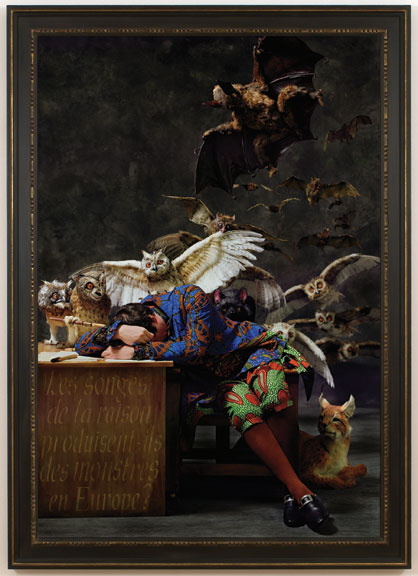
Yinka Shonibare, MBE, b.1962, The Sleep of Reason Produces Monsters (Europe), 2008, c-print mounted on aluminum. (c)Yinka Shonibare, MBE. Courtesy of James Cohan Gallery, New York.
Meadows Museum
Spanish Muse: A Contemporary Response
September 12 – December 12
The Museo del Prado and the Meadows come together for a significant exchange between two museums of the same name, in different languages. Meadows Museum Founder Algur H. Meadows’ vision of a “Prado on the Prairie” gets literal as Prado prepares to loan El Greco’s Pentecost, Ribera’s Mary Magdalene, and Velázquez’s Philip IV to Meadows, over a three-year period (one painting per year, in that order). In addition to this magnanimous loan of Spanish Golden Age masters, the museums will swap one curatorial intern annually—marking the first time Prado has accepted American interns (I feel you, Prado). Three years of related programming and exhibitions kick off with Spanish Muse: A Contemporary Response with works by international artists “responding to iconic works in Spain” including Thomas Struth, Eve Sussman, Yinka Shonibare, Manolo Valdés, José Manuel Ballester, and Claudio Bravo. Bravo indeed. –AG
Nasher Sculpture Center
Sightings: Alyson Shotz
October 2, 2010 – January 2, 2011
You might hazard a guess that Alyson Shotz was a geology major before she switched over to art; her installations give the sense that she knows a little something about crystalline forms and atomic structures. With the goal of making “volumes without mass,” Shotz uses slender materials like piano wire or translucent materials like Fresnel lenses to create cascading, seemingly weightless room-size forms. To inaugurate the Nasher’s new “Sightings” series (small-scale exhibitions and installations), Shotz will install a pair of elliptical sculptures, made from stainless steel wire strung with silvered glass beads, to create a “reflective, experiential environment.” That experience will be made complete with related wall drawings in the adjacent spaces as well as music specifically chosen for the installation by the artist and composer Simon Fisher Turner—perhaps something with strings? –AG
El Paso
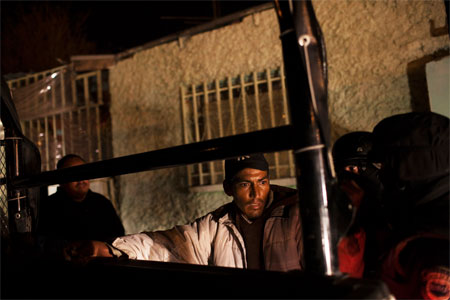
David Rochkind...Night Patrol #1...Ciudad Juárez, Chihuahua...2009...16 x 24 inches...Archival pigment print
Stanlee and Gerald Rubin Center for the Visual Arts at UTEP
Border 2010: Photographs by Alejandro Cartagena and David Rochkind
August 26 – November 13 2010 David Rochkind ’s startling images from his series Heavy Hand, Sunken Spirit are not staged: they are very real and very disturbing (be forewarned: some of the photographs on his website are not suitable for the young and/or sensitive, as they say). In the tradition of documentary photographers who somehow get access to people’s most nakedly private moments, Rochkind presents a gloomy portrait of Mexico’s drug war. By contrast, Alejandro Cartagena’s strangely empty images of quiet suburban life in Mexico provide an altogether opposite view—and a welcome change.–RK
El Paso Museum of Art
Museo de Arte de Ciudad Juárez
Border Art Biennial 2010 / Bienal Fronteriza de Arte 2010
November 14, 2010 – February 13, 2011
We don’t often get excited about EPMA’s shows, but the Border Art Biennial is noteworthy for being the first juried exhibition to feature artists from the states on the US/Mexico border: Arizona, Baja California, California, Chihuahua, Coahuila, New Mexico, Nuevo León, Sonora, Tamaulipas, and Texas. No word on whether the jurors (Rita Gonzalez, Assistant Curator at LACMA; and Itala Schmelz, Director at the Museo de Arte Carrillo Gil), are doing something thematic or not, and as of press time the details for the exhibit in Juarez had not been announced. But hopefully this show will uncover some gems. EPMA and the Museo de Arte de Ciudad Juárez deserve credit for tackling this project (each museum will exhibit one of two artworks by every artist selected). –RK
Fort Worth
Fort Worth Contemporary Arts
Yuri’s Office
September 18 – October 31
Opening September 18, 6 p.m.
Yuri’s Office is part of this fall’s DFW Eve Sussman extravaganza featuring screenings, exhibitions and lectures of and about the artist’s work. The show will include a life-sized replica of the office of cosmonaut Yuri Gagarin, the first man to orbit the earth. Sussman created the installation which has also served as a film set for her in-progress film White on White, described as “a ‘60s era cinema verité thriller, inspired by Jean Luc Godard’s film Alphaville—that moves from Moscow to the Caspian.” Sussman carefully constructed the set based on a photo she snapped of the cosmonaut’s roped-off office, now a tourist site. At the height of the space race, Gagarin was the Soviet celebrity, probably as widely-known as Lenin himself. Honing in on the bland Soviet-institutional office of a history-making adventurer is indicative of Sussman’s behind-the-scenes approach to film. (Her famed 89 seconds at Alcazar showed the subjects of Velazquez’s famed Las Meninas in the moments before and after the scene in the painting.) The exhibition is curated by Christina Rees and professor Noah Simblist (both Glasstire contributors!). –KK
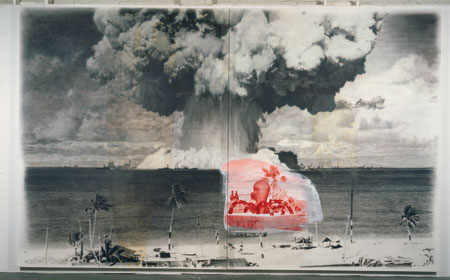
Vernon Fisher, Bikini, 1987, Acrylic on canvas, 11 ½ x 18 ½ inches, Collection of the Krannert Art Museum, Courtesy UT Press
Modern Art Museum of Fort Worth
Vernon Fisher: K-Mart Conceptualism
September 25, 2010 – January 2, 2011
Vernon Fisher has lived and worked in Fort Worth since 1977 so it’s fitting that the Modern is offering up this career survey. Organized by Michael Auping, the show will look at Fisher’s work as emblematic of painting in the 1970s and 80s, which had to contend with the developments of Pop Art and Conceptualism in the 1960s. Many of Fisher’s paintings function like what the philosopher Ludwig Wittgenstein called “language games”—the artist’s best-known blackboard paintings include texts and images culled from popular culture to create maps of information that are enigmatic constellations of art history, cartography and abstract form. –Noah Simblist
Also at the Modern…
Tuesday Evenings at the Modern
September 7 – November 16
This annual series of lectures, the likes of which no institution in Dallas-Fort Worth can compete with, includes a roster of international artists and curators. Upcoming speakers include: Lawrence Weiner, whose 2007 retrospective secured his place in the reigning royal family of Conceptual Art; the ubiquitous Bruce High Quality Foundation, oft-mentioned star of the recent Whitney Biennial; Los Angeles-based photographer Uta Barth; and Michelle White, Menil Collection Associate Curator, who will talk about her upcoming exhibition of early work by Vija Celmins. –NS
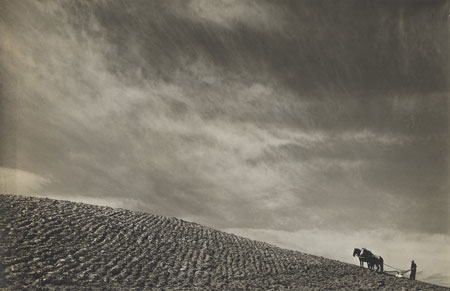
Margaret Bourke-White, 1906–1971, Iron Mountain, Tennessee, 1937 Gelatin silver print© Estate of Margaret Bourke-White/ Licensed by VAGA, New York, NY, Margaret Bourke-White Collection, Special Collections Research Center, Syracuse University Library, American Modern 9
Amon Carter Museum
American Modern: Abbott, Evans, Bourke-White
October 2, 2010 – January 2, 2011
This exhibition highlights the work of three American photographers in the 1930s. The 1930s were a golden age for documentary photography, a time when the Museum of Modern art was established, the U.S. government sponsored a number of photography exhibitions and picture-based publications like Life magazine arose. Featuring the work of Berenice Abbott, Margaret Bourke-White and Walker Evans, the exhibition reflects the energy of the period as well as the excitement that these artists felt combining a relatively new medium with modernist formal sensibilities as they explored its potential to capture images of the everyday.
The notion of the everyday for photographers like Walker Evans was not just a matter of record keeping or journalism. It was also a way to communicate the social and economic conditions of their work’s sites and subjects. The exhibition takes a careful look at the notion of documentary photography, as it straddled mass media and fine art. –NS
Houston
Inman Gallery
Emily Joyce: New Math
September 10 – October 23
If I were to describe Emily Joyce’s work, I’d say “intricately patterned, colorful vinyl collage,” but I’d be wrong. With “New Math,” Joyce leaves behind ethenyl for paper and ink. Inspired by Ando Hiroshige’s 19th Century series of ukiyo-e prints, One Hundred Famous Views of Edo (which also rocked the world of Whistler and Van Gogh), Joyce began working with a master printer to translate her complex layering techniques to squeegee and screen. This translation required Joyce to develop a “new math” or a different strategy for pattern creation—as those who have silkscreened before know, it’s bass ackwards. Joyce says her interest was in creating a grid that bounces the eye between unit, pattern and whole. With some paintings requiring more than “1000 pulls of the squeegee,” plus hand-painting and airbrush, Joyce’s laborious paintings are sure to float your world. –AG
Aurora Picture Show and Cynthia Woods Mitchell Center for the Arts
Media Archeology: Texas Focus
September 16–18
Various venues
Media Archeology, Houston’s annual cabaret-style, multimedia festival returns for lucky year number seven, under the auspices of Aurora Picture Show and Mitchell Center for the Arts. The term “media archeology” comes from remix culture’s creative reuse of all media—film, video, TV, bits, bytes and the technology that serves it up. “Texas Focus” is this year’s theme, with presenting artists all residing within the borders of this great state. Austin-based Luke Savisky will perform live film projections on the surface of three abandoned grain silos in the East End. San Antonio’s Potter-Belmar Labs will revive and remix the 1967 Swedish film “I Am Curious (Yellow)” at Heights Theater—the site that was torched by a prudish protestor when the film screened there in 1969. Rumor has it the melted film print is still in the 35mm projector on site. And lastly, the Houston cell of Graffiti Research Labs will project “non-destructive, digital graffiti” on the exterior of The Menil Collection. No Menil Collection cedar siding will be harmed. –AG (Andrea Grover is the founder of Aurora Picture Show.)
Rice University Art Gallery
Sarah Oppenheimer: D-17
September 16 – December 5
Last year I visited a Sarah Oppenheimer exhibit at Mattress Factory, Pittsburgh, and was treated to my favorite kind of art experience—one that contained elements of surprise and peril. A small fourth floor gallery had what appeared to be a surfboard-sized depression in the wood floor, but on closer inspection, it was a gaping hole with a tapered, shoot-like aperture aimed at the neighbor’s outdoor dining set. The opening appeared large enough for a body to slide down some four stories and crash into the middle of a backyard barbeque. The work, titled 610-3356, is typical of the obliquely-named, architectural “wormholes” that Oppenheimer introduces into solid edifices. For D-17, the artist aims to create a 60-foot channel-like hole through the Rice Gallery’s exterior windows. In a three-day intensive summer workshop, Oppenheimer and Rice architecture students experimented with various mock-ups, which ultimately determined the final form for D-17. Each step of the installation can be followed (but hopefully not mimicked) on the Rice Gallery website. –AG
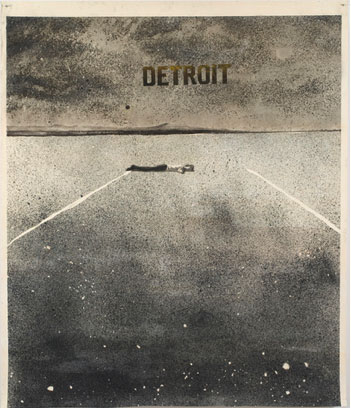
Edgar Arceneaux, Detroit, 2009, Acrylic, graphite on paper, 185 x 156,5 cm, Photocredit Lutz Bertram, Berlin
Project Row Houses
Round 33
The Seventh House: Curated by Nery Gabriel Lemus and Edgar Arceneaux
October 9, 2010 – February 27, 2011
The Seventh House in Astrology is the house of cooperation and opposition, and a full moon in it hearkens to the “Age of Aquarius,” per the musical Hair anyway. But The Seventh House at Project Row Houses has more to do with cooperation across generations—a concept not embraced by the Hippies (“Don’t trust anyone over 30”), or aided by the categorization of cultural groups into Boomers, X-ers, Millennials, etc. The six individuals in this exhibit represent different generations of LA-based artists, including Charles Gaines, Rodney McMillian, Olga Koumoundouros, Andrea Bowers and the curators, Nery Gabriel Lemus and Edgar Arceneaux (director of PRH’s sister venture, Watts House Project, LA). All the work they’ve ever created collaboratively (in a “scaled-down version”) will be on view, plus one site-specific work by each artist. A newly minted BBQ pit for PRH’s Young Mother’s program, designed by artists Andrea Bowers and Olga Koumoundouros, will ensure that food and conversation are among the many things shared at Round 33. –AG

Peter Bissegger, Reconstruction of Kurt Schwitters's Merzbau, original Merzbau ca. 1930-37, destroyed 1943, reconstruction 1981-83,154-3/4 x 228-3/8 x 181 inches, Sprengel Museum Hannover, Photo: Michael Herling / Aline Gwose, Sprengel Museum Hannover (c) Peter Bisseger
The Menil Collection
Kurt Schwitters: Color and Collage
October 22, 2010 – January 30, 2011
It’s been 25 years since MoMA’s Kurt Schwitters show, the last comprehensive U.S. exhibition, and The Menil Collection brings it. As a pioneer of three-dimensional collage and interdisciplinary art, Schwitters has been called “the grandfather of Pop Art, Happenings, Concept Art, Fluxus, multimedia art and post-modernism" by biographer Gwendolyn Webster. In 1919, Schwitters coined the term “Merz” (named after a fragment of advertising) to give an all-encompassing name to his assemblages, collages, drawings, sculptures, prints, poetry and so on. For the first time in the U.S., Schwitters’ Merzbau—a precursor to installation art—will be recreated at The Menil. Begun three times and destroyed by an Allied bombing during WWII, Merzbau was Schwitters’ “life work” and involved converting multiple rooms of his house into a living sculpture. The walls and ceilings were covered with three-dimensional shapes and each room was stuffed with both found and constructed materials. This, and over 100 Schwitters assemblages, collages and sculptures will be on view. Merz-y me. –AG
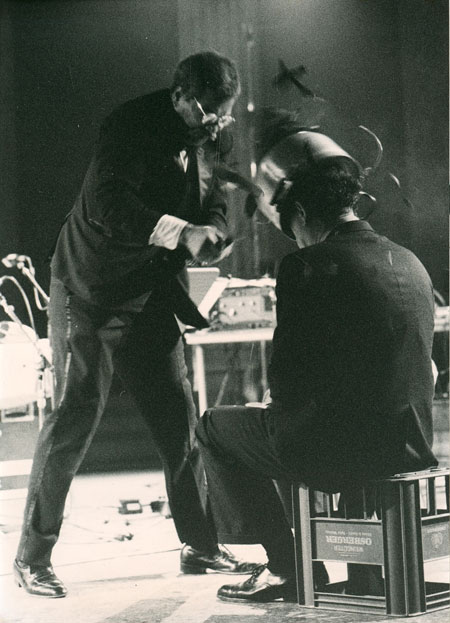
Benjamin Patterson’s restaging of Nam June Paik’s One for Violin, 1962. Benjamin Patterson and Bertrand Clavez performing at the Ecole Nationale des Beaux-Arts, June 1989. Courtesy the artist. Photo: Wolfgang Traeger.
Contemporary Arts Museum Houston
Benjamin Patterson: Born in the State of FLUX/us
November 5, 2010 – January 20, 2011
“cover shapely female with whipped cream
lick
…
topping of chopped nuts and cherries is optional.”
So reads Benjamin Patterson’s iconic Fluxus score, Lick Piece (1964). A photograph documenting the performance depicts a naked woman with eyes shut, being sprayed with canned whipped cream by a group of fully clothed men. As the only African American founding member of the Fluxus movement, “Ben” Patterson could afford to take some liberties with sexuality and race in the era of Civil Rights. Benjamin Patterson: Born In the State of FLUX/us is the long overdue, first major U.S. exhibition of the artist’s work, spanning some fifty years and including audio, video, performance artifacts, artist’s books, installation and sculpture. Patterson, who was classically trained as a double bassist and composer, was known for introducing musical structure to Fluxus scores (simple instructions to be performed by anyone). Patterson also was instrumental in organizing the first International Festival of New Music (Wiesbaden, Germany, 1961), which featured now legendary composers John Cage, Dick Higgins and David Tudor. Radical music, you might surmise, strikes a major chord in Patterson’s exhibition. –AG
Lubbock
Texas Tech University Landmark Arts Gallery
Natalie Cheung: Intermediaries: Cyanotype Photogram
November 22 – December 18
Natalie Cheung‘s practice fits within the recent resurgence of interest in historical processes of wet plate photography. She makes photographs without a using a camera, experiments with the 20th century innovations of chemigrams and photograms, which involve some combination of chemistry, photographic materials, time lapse and light. Cheung’s resulting images are luminous, abstract and—at the risk of trivializing—very easy on the eye. Texas Tech will feature her Cyanotype Photogram series, images she’s made from evaporated chemicals. In other bodies of work, she’s produced an abstracted image randomly, then researched art history to find a similar antecedent, linking the two and questioning the roles of chance vs. intent in art. Nice work coming from this recent MFA grad from Temple University in Philadelphia. –RK
Marfa
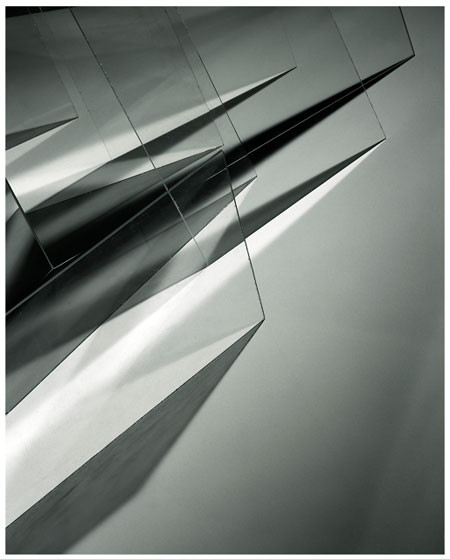
Barbara Kasten...Studio Construct 17, 2007, 2/5... 56 x 46 x 3 inches...Archival Pigment, print on Harman paper, mounted on Diebond
Ballroom Marfa
Immaterial
October 1, 2010 – February 20, 2011
Curated by Founder and Director Fairfax Dorn, Ballroom Marfa’s Immaterial is a show of abstract art. Though this seems fitting in the context of Ballroom Marfa’s neighboring Chinati Foundation, it’s a bit of a departure for a space that in recent years has focused more on installations and performances, and not so much on pretty objects. It being Marfa, their press release drops phrases like “the physical and psychic tensions between form, color and space” and “art’s potential to transcend conscious states through a plurality of visual languages” and “an image or object which can create both physical and psychological spaces.” But don’t let the poetical redundancies lull you to sleep or drive you to drink; instead note that Ballroom has put together a show that features a nice roster of international artists—all of whom are women—without describing it as a show of women artists! It’s the most promising show in Marfa in a while. –RK
McAllen
International Museum of Art and Science
Nancy Moyer: Bicameral Face
Nov 20, 2010 – Mar 6, 2011
What if our faces were perfectly symmetrical? South Texas artist Nancy Moyer explores this idea, extrapolating two very different personalities from the two sides of her subjects’ faces, which she photographs and replicates, left and right. Moyer is influenced by the idea of the left and right sides of the brain having certain characteristics, and takes the notion one step (too far?) by labeling all her subjects’ left side portraits “Facilitator” and their right side portraits “Commander” (if they’re right-handed; if they’re left-handed, it’s the opposite). But the somewhat hokey premise actually plays out Moyer’s images: the "Commander" side of each subject’s face, when mirrored, makes a more grumpy, assertive face than the "Facilitator" side, which looks more appealing and plaintative. Primordial archetypes at work, coincidence, or Moyer’s own machivellian machinations? Travel down to McAllen and you be the judge. –RK
San Antonio
San Antonio Art League Museum
Marilyn Lanfear: Artist of the Year
September 12 – October 22
Marilyn Lanfear turns dresses into lead, part of her conceptual approach to bringing family stories from her Texas childhood to life, in her one-woman Artist of the Year show at the San Antonio Art League Museum. One of her largest installations, Daddy’s Two Death Stories, featuring her father’s reclining shirt in a cast iron bed in front of a window with carved wood curtains, is based on a night when her father was five and suffering from a mysterious illness. He overheard a doctor say he wouldn’t live through the night, though he survived until he was 85. Aunt Opal’s Hat is made of lead and rests on a pedestal similar to ones used to display Japanese samurai helmets. Using wood, stone, paper, buttons, cotton gin weights and other found materials, she infuses her sculptural collages with irony and symbolism. Lanfear, who has an MFA from the University of Texas at San Antonio, says she wasn’t really a storyteller until she lived in New York for a few years and realized people don’t have family stories like the ones told in Texas. –Dan R. Goddard
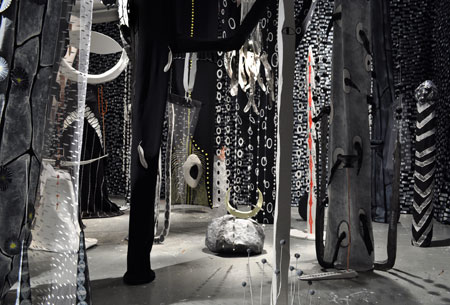
Mathew Ronay. Between the Worlds, 2010. Installation view. Photo courtesy of the artist and Andrea Rosen Gallery, New York.
Artpace
Matthew Ronay: Between Two Worlds
September 23, 2010 – January 2, 2011
While his earlier sculptures sometimes resembled discarded toys, though loaded with cultural, political and sexual intrigue, New York artist Matthew Ronay’s latest work is less sensationalistic, featuring more muted organic elements in earth tones, but he continues to address human behavior in times of social upheaval. After previously being obsessed with pornography and terrorism, he has moved on toward shamanism, the earth and underwater creatures. He created the installation Matthew Ronay: Between Two Worlds especially for Artpace, and later it will move to New York’s Andrea Rosen Gallery. Centered on a form in several cloaks, resembling a high priest crowned with a massive white crescent headpiece, the theatrical setting includes big scary trees, wise old owls and curious monsters of all shapes and sizes in black and white. Ronay, who was included in the 2004 Whitney Biennial, is known for using simple materials in handmade artifacts, but his work often plays with or undermines the artifice of art. Artpace director Matthew Drutt, who curated this show, collaborated with Ronay on a project at Austin’s testsite in the fall of 2008. –DRG

Blue Star Contemporary Art Center
Causal Observer
September 30 – November 6
Enigmatic and a little mysterious, San Antonio artist Hills Snyder, who operates Sala Diaz and curated the pioneering Lonely Are the Brave exhibit last year, will spend all of September (when he isn’t strumming on his guitar) working in an open studio at the Blue Star Contemporary Art Center, creating pieces for his one-man show Causal Observer. In his last exhibit at Three Walls, Cat Tois, Snyder built a living-room-size miniature of the Eiffel Tower covered with cut-up pieces of a Persian rug—which the artist said he planned to use as a cat tower/scratching post. In a memorable appearance at Artpace’s annual Chalk It Up, Snyder dressed up like a character from The Flesh and the Fiends and slowly and menacingly ground up pieces of chalk in a pencil sharpener. The amateur musician says Causal Observer is the “fourth in a series of projects derived from his 1997 murder ballad Song 44” and “will allow for the attentive viewer to make something happen.” –DRG

Female Figurine, Predynastic Period, Naqada IIa Period, ca. 3650 -3300 B.C.E., Terracotta, painted 13 3/8 x 5 x 2 1/2 in. (34 x 12.7 x 6.4 cm), reportedly from: Ma'mariya, Egypt, Africa, Charles Edwin Wilbour Fund
McNay Art Museum
Landscapes from the Age of Impressionism
October 6 – January 16
San Antonio Museum of Art
To Live Forever: Egyptian Treasures from the Brooklyn Museum
October 16 – January 9
The Brooklyn Museum is sending highlights from two of its best-known collections to San Antonio this fall. Chronicling the evolution of 19th century French plein air painting and its influence on early 20th century American artists, Landscapes from the Age of Impressionism at the McNay Art Museum features 40 paintings ranging from leading French artists such as Gustave Courbet, Alfred Sisley, Camille Pissarro and Claude Monet to their most significant American followers, including Frederick Childe Hassam, John Singer Sargent and Williams Glackens. More than 100 objects exploring the ancient Egyptians’ beliefs about life, death and the afterlife make up To Live Forever: Egyptian Treasures from the Brooklyn Museum at the San Antonio Museum of Art. “Bird Lady,” one of the oldest preserved Egyptian statues in the world, is included along with a painted limestone relief of Queen Neferu and the elaborately painted shroud of Neferhotep. Other objects include impressive stone and painted wood coffins, jewelry, protective amulets and the mummy of a wealthy man named Demetrios. Each section contains funeral objects for the rich, the middle class and the poor. –DRG
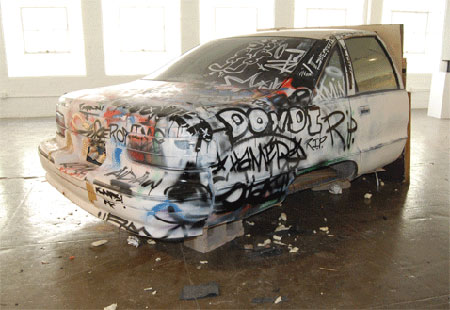
William Cordova, Mark Aguilar, and Carlos Sandoval de Leon, Moby Dick(Tracy) (after ishmael, chico de cano y carl hampton), 2008, 1/2 Chevrolet Caprise police car, plywood, cinder blocks, packaging tape, spray paint, corrugated metal,wood, found pipe bomb
David Shelton Gallery
The Ballad of the Non-Specific Object
October 16 – November 27
One of the independent projects Anjali Gupta is pursing after resigning as executive director and editor-in-chief of Art Lies is curating The Ballad of the Non-Specific Object for the David Shelton Gallery. The show is a response to a Jerry Saltz article that contained this quote:
“Non-Specific Objects accept that power and passivity often meld and exist simultaneously, and that monolithic modes of thinking aren’t a rich enough way to see the world. They grasp that just because you are not sure doesn’t mean you’re not confident. I would only add that Non-Specific Objects are nearly always sincere and ironic at the same time.”
Gupta has lined up some pretty great artists as "respondents," among them Nate Cassie of San Antonio, William Cordova of Miami, Sasha Dela of Houston, Ian Pedigo of New York and Allison Weise of San Diego. Besides editing the state’s leading art journal for seven years, Gupta wrote for tema celeste, Art Papers, Art Asia Pacific, artUS and Public Art Review, as well as numerous gallery and museum catalogues including American Art Since 1900 (Blanton Museum of Art, 2006). Gupta knows her stuff; this should be a smart and provocative show. –DRG
Tyler
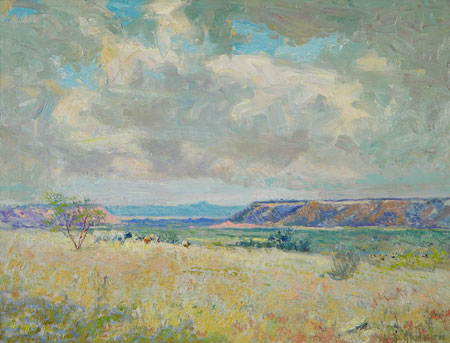
L.O. (Louis Oscar) Griffith (American, 1875–1965)...Untitled (Southwest Landscape)...Oil on canvas mounted on board...18 x 24 inches...Collection of Bobbie and John L. Nau, III
Tyler Museum of Art
L.O. Griffith: Painting the Texas Landscape
September 19, 2010 – January 2, 2011
Louis Oscar Griffith (1875-1956) is known more as an Indiana painter than a Texas one, mainly because he grew up in Dallas but left in 1893 at the age of 18, never to return. But in his formative years he was a protégé of the iconic Frank Reaugh, with whom Griffith traveled throughout the Southwest by covered wagon. This exhibition, organized by the Tyler Museum, will feature about 70 works that have not been seen by the general public or scholars in almost a century. The works were created from those excursions with Reaugh, and feature Buzzards’ Peak in King’s County, the Edwards Plateau and the Big Bend area. For fans of early Texas painting, this is the most exciting show to come up in a long time, and one which might challenge the notion that Griffith’s main contribution to American Impressionism was the Midwestern work of his later years. –RK



